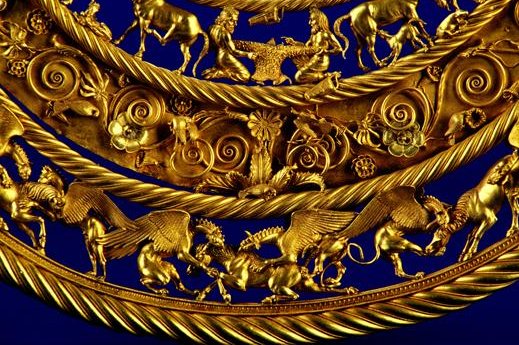
The Golden Pectoral, a neckpiece, is an ancient Scythian artifact found in a burial kurgan at a site in southern Ukraine in 1971.
Photo courtesy D. Kolosov/Wikimedia
April 30 (UPI) -- Russian forces stormed the Melitopol Museum of Local History and stole rare Scythian gold artifacts, according to officials in Ukraine.
"The orcs have taken hold of our Scythian gold," Melitopol Mayor Ivan Fedorov said, according to Ukrinform -- the nation's information and news agency.
"This is one of the largest and most expensive collections in Ukraine, and today we don't know where they took it, whether it was hidden or stolen. We don't know about its fate, but of course this gold has been stolen from our community, and I hope that we will be able to get it back."
Leila Ibrahimova, the director of the Melitopol Museum of Local History, told The New York Times that Russian forces had kidnapped a museum caretaker at gunpoint and ordered her to show them the artifacts that the museum had hidden earlier in the invasion.
A "mysterious man" in a white lab coat was with the troops when they showed up at the museum on Wednesday and used special gloves to steal the ancient artifacts from the cardboard boxes where they had been stashed in the museum's cellar, The New York Times reported.
In all, Russian troops looted at least 198 gold items, rare old weapons, centuries-old silver coins and special medals, Ibrahimova said.
Ibrahimova herself was kidnapped by Russian forces in mid-March, according to a press release at the time from the National Museum of the Holodomor-Genocide in Kyiv.
"The occupiers are purposefully repressing representatives of Ukrainian culture, intimidating Ukrainians, and threatening the most active ones," the Holodomor Museum alleged in its statement.
Ibrahimova was questioned and released after she and other museum staff members had tried to hide the precious artifacts in the cellar when control of the city was taken by Russian forces.
"We knew that any second someone could come into the museum with a weapon," she said. "We hid everything but somehow they found it."
April 30 (UPI) -- Russian forces stormed the Melitopol Museum of Local History and stole rare Scythian gold artifacts, according to officials in Ukraine.
"The orcs have taken hold of our Scythian gold," Melitopol Mayor Ivan Fedorov said, according to Ukrinform -- the nation's information and news agency.
"This is one of the largest and most expensive collections in Ukraine, and today we don't know where they took it, whether it was hidden or stolen. We don't know about its fate, but of course this gold has been stolen from our community, and I hope that we will be able to get it back."
Leila Ibrahimova, the director of the Melitopol Museum of Local History, told The New York Times that Russian forces had kidnapped a museum caretaker at gunpoint and ordered her to show them the artifacts that the museum had hidden earlier in the invasion.
A "mysterious man" in a white lab coat was with the troops when they showed up at the museum on Wednesday and used special gloves to steal the ancient artifacts from the cardboard boxes where they had been stashed in the museum's cellar, The New York Times reported.
In all, Russian troops looted at least 198 gold items, rare old weapons, centuries-old silver coins and special medals, Ibrahimova said.
Ibrahimova herself was kidnapped by Russian forces in mid-March, according to a press release at the time from the National Museum of the Holodomor-Genocide in Kyiv.
"The occupiers are purposefully repressing representatives of Ukrainian culture, intimidating Ukrainians, and threatening the most active ones," the Holodomor Museum alleged in its statement.
Ibrahimova was questioned and released after she and other museum staff members had tried to hide the precious artifacts in the cellar when control of the city was taken by Russian forces.
"We knew that any second someone could come into the museum with a weapon," she said. "We hid everything but somehow they found it."
The Scythians were nomadic people that migrated from Iran to southern Russia and Ukraine around 800 B.C.E. and an empire centered in what is now Crimea, the region of Ukraine annexed by Russia in 2014.
The United Nations Educational, Scientific, and Cultural Organization on Tuesday confirmed Tuesday that at least 110 sites have been destroyed since the start the invasion on Feb. 24.
Russia's scorched-earth tactics have led to the destruction of at least 48 religious sites, 10 museums, 22 historic buildings, 11 buildings dedicated to cultural activities, 13 monuments and six libraries.
Museums that have been damaged or destroyed include the Ivankiv Museum in the Kyiv region, the Regional Art Museum in Chernihiv and the Kharkiv National Academic Opera and Ballet Theater.
Concern over the cultural artifacts of Ukraine has led international institutions such as Venice's Civic Museums to send supplies to Ukrainian museums to help secure such priceless art and artifacts.
The Lviv National Art Gallery will receive protective fabrics, foam panels and data loggers for tracking changes in humidity and temperature from the museums in Venice, Italy, The Art Newspaper reported.
According to the outlet, the donation is part of Save Ukraine Art 22 - an initiative from private companies and public institutions to create a supply chain of materials to help Ukrainian museums save the art.
The Art Newspaper noted that the Lviv National Gallery, a network of 18 museums, has also attempted to hide its collection of 67,000 works from the Russian invaders.
No comments:
Post a Comment